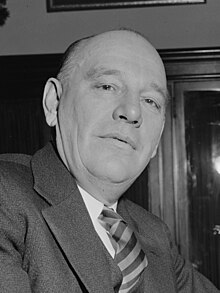Ernest Lundeen | |
|---|---|
 Lundeen in April 1940 | |
| United States Senator from Minnesota | |
| In office January 3, 1937 – August 31, 1940 | |
| Preceded by | Guy V. Howard |
| Succeeded by | Joseph H. Ball |
| Member of the U.S. House of Representatives from Minnesota | |
| In office March 4, 1933 – January 3, 1937 | |
| Preceded by | General Ticket Adopted |
| Succeeded by | Henry Teigan |
| Constituency | General Ticket seat 8 (1933-1935) 3rd district (1935-1937) |
| In office March 4, 1917 – March 3, 1919 | |
| Preceded by | George Ross Smith |
| Succeeded by | Walter Newton |
| Constituency | 5th district |
| Member of the Minnesota House of Representatives from the 42nd district | |
| In office January 3, 1911 – January 4, 1915 | |
| Preceded by | William Campbell and John Godspeed |
| Succeeded by | John Sanborn Jr. and George Sudheimer |
| Personal details | |
| Born | August 4, 1878 Beresford, Dakota Territory, U.S. |
| Died | August 31, 1940 (aged 62) Lovettsville, Virginia, U.S. |
| Cause of death | Plane crash |
| Political party | Republican (?-1925) Minnesota Farmer-Labor Party (1925-1940) |
| Spouse | Norma Lundeen |
| Alma mater | Carleton College University of Minnesota Law School |
| Military service | |
| Branch/service | United States Army |
| Unit | Company B-12th Minnesota Volunteer Regiment |
| Battles/wars | Spanish–American War |
Ernest Lundeen (August 4, 1878 – August 31, 1940) was an American lawyer and politician who represented Minnesota in the United States House of Representatives from 1917 to 1919 and 1933 to 1937 and the United States Senate from 1937 until his death in 1940. He was a member of the Republican Party before joining the Minnesota Farmer–Labor Party, and he opposed American involvement in World War I and World War II. He was also affiliated with the Nazi Party of Germany.
A veteran of the Spanish–American War, he got his beginning in politics when he served in the Minnesota House of Representatives from the 42nd district, between 1911 and 1914. Originally elected as a Republican, he represented Minnesota's 5th congressional district for a single term between 1917 and 1919, and lost renomination in 1918 due to his opposition to American entry into World War I. He was killed in a plane crash near Lovettsville, Virginia, on the afternoon of August 31, 1940, along with 24 others. At the time of his death, he was the subject of a probe by the Federal Bureau of Investigation due to his ties to Nazi Germany.